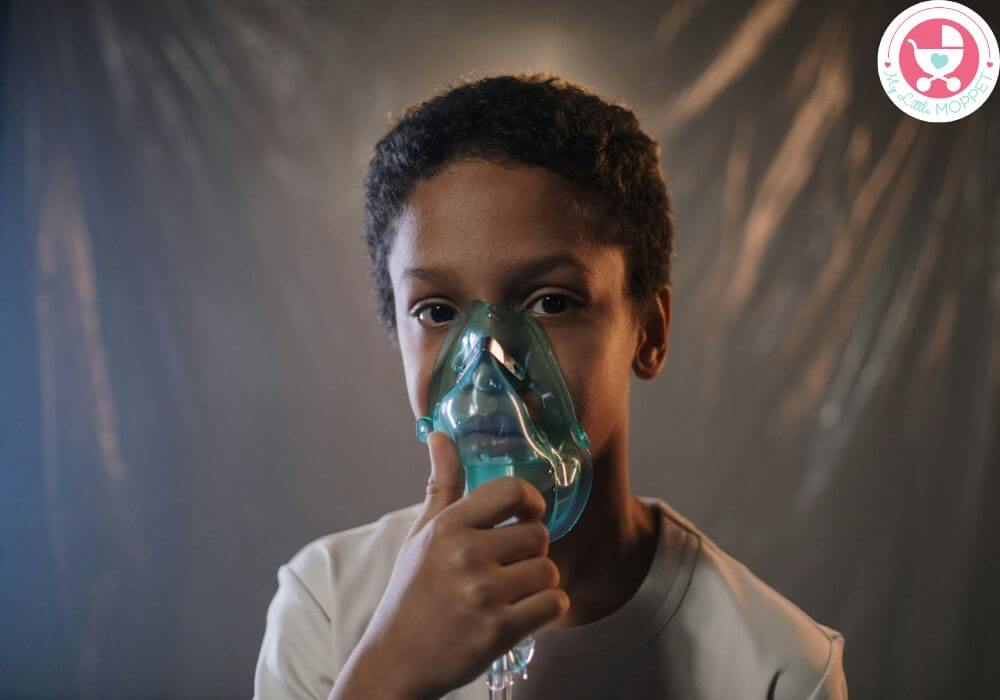Here’s everything you need to know about asthma in children – signs, causes, diagnosis, treatment and ways to prevent attacks in the future.
Asthma is something we’ve heard a lot about, but we aren’t really sure about what it is. Is coughing asthma? Or sneezing when exposed to dust?
The fact is that asthma is one of the most common conditions affecting children across the world, but most parents don’t know much about it. Asthma in children causes them to miss school, while affecting their ability to study, play or participate in sports. In extreme cases, asthma can lead to hospitalization or permanent damage to the lungs.
Since it’s World Asthma Day on 6th May, we’re going to take a look at what this condition is, and what asthma in children looks like.
What is Asthma?

Asthma is a chronic disease that affects the lungs and airways. A person with asthma finds it difficult to breathe as the airways swell, becoming narrow. As you can see in the image above, a normal airway has enough space for air to pass through, unlike airways affected by asthma.
When the lungs don’t get sufficient air, the person begins to wheeze or cough, and can experience a tightness in the chest. Since children’s bodies and immune systems are still developing, they are particularly vulnerable to the ill effects of asthma.
Most children experience their first symptoms of asthma before the age of five. If left untreated, asthma can lead to lifelong breathing difficulties, some of which can even be dangerous. That’s why it helps to be informed on asthma in childhood, and to know what the signs, causes and treatment options are.

- Among children, males are more likely to have asthma than females, but in adulthood, females are more likely to have asthma
- Asthma is the most common chronic medical condition among children
- Nearly 44% of children with asthma are estimated to have uncontrolled asthma
- Asthma leads to more school absences and hospitalizations than any other chronic illness
- India has a three times higher mortality rate from asthma compared to global numbers
- 6% of children in India currently suffer from wheezing
Causes of Asthma in Children

It is difficult to pinpoint an exact cause for asthma in children, but many risk factors increase the likelihood of a child getting asthma.
- A family history of asthma, particularly parents or siblings
- Having viral respiratory infections early in life, like those due to human rhinovirus
- Pre-existing allergic conditions like eczema or rhinitis
- Exposure to secondhand cigarette smoke, even before birth
- Low birth weight or premature birth
- Exposure to environmental allergens like dust mites, mold, pests, fumes or chemicals
- Obesity
- Smoking by the mother during pregnancy
- Mother being under 20 at the time of birth
- Vitamin D deficiency during pregnancy
- Living in regions of high air pollution
- Chronic gastroesophageal reflux disease (GERD)
Signs of Asthma in Children

- Shortness of breath, especially during play or exercise
- Wheezing – a whistling sound when breathing
- Frequent coughing, especially during activity or at night
- Tightness in the chest
- Repeated episodes of respiratory infections like pneumonia or bronchitis
- Delayed recovery after a respiratory infection
- Trouble sleeping
- Fatigue
Not all kids exhibit all these symptoms; symptoms of asthma in children vary from child to child, depending on the severity of the condition. Some of these symptoms may also be due to conditions other than asthma, like infectious bronchitis. Most of these symptoms appear in response to triggers like these:
- Viral infections
- Exposure to pollutants in the air, like tobacco smoke
- Dust mites, pollen, mold or pet dander
- Cold air or a change in weather
- More than usual physical activity
- Strongly scented soaps or personal care products
Diagnosis of Asthma in Children

If you notice any of the symptoms mentioned above, get your child checked as soon as possible. This is crucial since asthma is known to be underdiagnosed, despite being among the most common chronic conditions among children.
When you visit the doctor, they may ask several questions about your child’s symptoms, especially about breathing difficulties during sleep or activity. You may also be asked if the symptoms worsen during specific times of the year, and how long they usually last.
The doctor will also take your family history to get a better idea of your child’s medical condition. In some cases, your pediatrician may refer you to a specialist – either a pediatric pulmonologist or a pediatric allergist.
If your child is over 5 years of age, your doctor may recommend some tests. The most common one recommended by the National Asthma Education and Prevention Program (NAEPP) is spirometry, which tests how much air goes in after taking a deep breath. Other tests include bronchoprovocation testing, peak flow monitoring, chest X-rays and allergy tests.
Treatment of Asthma in Children

Once your child has been diagnosed, you’ll probably start looking for treatment options. Unfortunately, asthma can’t be cured completely, it can only be managed to control the symptoms and help the patient live a full and healthy life.
Your doctor will create an asthma plan with you so you and your child’s other caregivers know how to move forward and what to do during an asthma attack. The doctor may also prescribe medicines, either as a pill to swallow or an inhaler to breathe in.
Inhalers are quite popular, since they deliver the medicine directly into the lungs, offering faster relief. There are two types of inhalers – bronchodilators (which open up the air passages), and steroids (which reduce inflammation in the airways).
Your child’s asthma severity will determine which inhaler to use and how often they need to use it. A device called a spacer makes it easier for kids to use inhalers. Make sure to communicate your child’s asthma plan with their teachers and other school staff.
Tips to Prevent Asthma Attacks in Children

While asthma in children can’t be prevented, the frequency of asthma attacks certainly can be controlled. The fewer asthma attacks your child has, the better their overall respiratory health will be. However, there are a few steps you can take to ensure your child stays healthy, which are mostly about limiting exposure to triggers like smoke and dust.
- Cigarette Smoke: First of all, don’t expose your child to secondhand or even thirdhand smoke. If someone in your home or family smokes, ask them to stop right away.
- Dust Mites: Avoid rugs and carpets as far as possible. If you do have them, vacuum them regularly, along with mattresses. Wash bedding and bath linen weekly and choose allergen-proof mattresses and pillows.
- Mold: Mold spores grow in humid areas or places with moisture, like kitchens and bathrooms. Check for water damage and fix it. Switch on the exhaust fans or open a window in bathrooms. Dry all surfaces after cleaning.
- Humidity: This is a major cause for mold, so use a dehumidifier or A/C to keep the indoor humidity low. Check refrigerator drip pans and keep them clean.
- Smoke: Use an exhaust fan in the kitchen to let the cooking fumes out. If you have a fireplace, ensure proper ventilation so the smoke escapes out.
- Air Pollution: Use an air purifier with a HEPA filter to clean indoor air. Replace or clean A/C filters as required and keep drain lines flowing and drip pans clean.
- Volatile organic compounds (VOCs): These come from personal care products, perfume or cleaning products. Switch to cleaner products, or use them only when the patient is not present.
- Pests: Keep kitchen counters and sinks completely clean. Wipe up spills and sweep up crumbs immediately. Cover food and seal cracks in the walls. If the problem is severe, call in pest control services.
- Pets: Pets, particularly furry pets, tend to shed everywhere. You may have to keep your pets elsewhere, or at least keep them out of your bedroom, and wash them frequently.
- Obesity: Help your child eat more nutritious food and less processed foods with added sugar. Encourage them to stay physically active so they can maintain a healthy weight.
- Reflux: Acid reflux worsens asthma in children, so monitor your child’s diet so you can avoid triggering foods, and keep antacid medication on hand.

Along with following all these tips, it is important to check in with your child’s doctor frequently so you’re always on top of your child’s respiratory health. If you notice any new symptoms, don’t wait for them to get worse – ask your doctor without delay. Don’t forget to administer medicine as per your doctor’s prescription.
Rush your child to the ER if you notice any of these symptoms:
- Excessive shortness of breath that prevents speaking a full sentence
- Use of abdominal muscles to breathe, sucking it in hard
- Nostrils flaring out when breathing
References:
Buy Healthy Nutritious Baby, Toddler food made by our own Doctor Mom !
<!–
–>
!function(f,b,e,v,n,t,s)
{if(f.fbq)return;n=f.fbq=function(){n.callMethod?
n.callMethod.apply(n,arguments):n.queue.push(arguments)};
if(!f._fbq)f._fbq=n;n.push=n;n.loaded=!0;n.version=’2.0′;
n.queue=[];t=b.createElement(e);t.async=!0;
t.src=v;s=b.getElementsByTagName(e)[0];
s.parentNode.insertBefore(t,s)}(window, document,’script’,
‘https://connect.facebook.net/en_US/fbevents.js’);
fbq(‘init’, ‘155662071843833’);
fbq(‘track’, ‘PageView’);
!function(f,b,e,v,n,t,s)
{if(f.fbq)return;n=f.fbq=function(){n.callMethod?
n.callMethod.apply(n,arguments):n.queue.push(arguments)};
if(!f._fbq)f._fbq=n;n.push=n;n.loaded=!0;n.version=’2.0′;
n.queue=[];t=b.createElement(e);t.async=!0;
t.src=v;s=b.getElementsByTagName(e)[0];
s.parentNode.insertBefore(t,s)}(window, document,’script’,
‘https://connect.facebook.net/en_US/fbevents.js’);
fbq(‘init’, ‘1129675213727539’);
fbq(‘track’, ‘PageView’);
(function(d, s, id) {
var js, fjs = d.getElementsByTagName(s)[0];
if (d.getElementById(id)) return;
js = d.createElement(s); js.id = id;
js.src = “//connect.facebook.net/en_US/sdk.js#xfbml=1&version=v2.3”;
fjs.parentNode.insertBefore(js, fjs);
}(document, ‘script’, ‘facebook-jssdk’));
Source link


